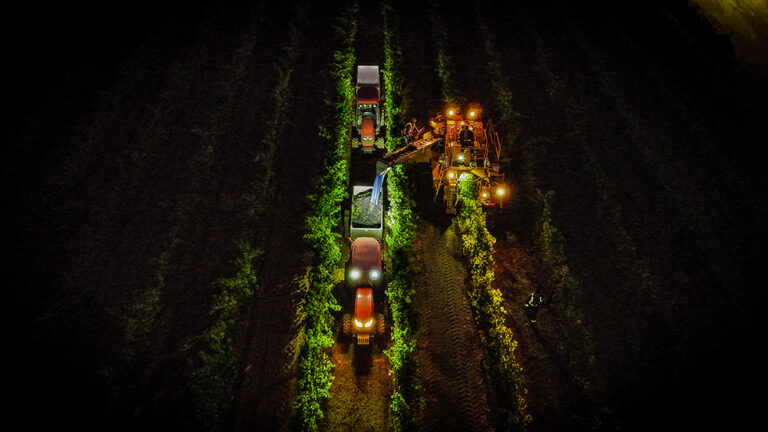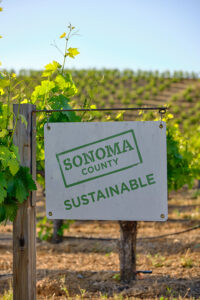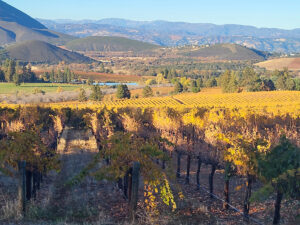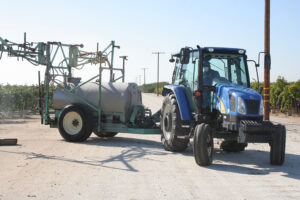
Karissa Kruse could easily adopt a bearish outlook for the grape and wine sector this year.
As president and CEO of Sonoma County Winegrowers, she’s well aware of the industry’s challenges, from inflated input costs and worrisome labor challenges to slowing wine demand and increasing competition from ready-to-drink alcoholic beverages.

Yet Kruse chooses to see the glass as half full.
“We’re coming into 2024 with one of the best vintages in the history of Sonoma County,” she said. “The wineries are very excited, and the farmers are happy.”
Moreover, Kruse believes her association’s “Farm of the Future” efforts in sustainability and regenerative farming bode well for Sonoma County’s 1,800 winegrape growers and 60,000 acres of vineyards. And the organization’s new demand-building collaborations with the Houston Rockets basketball team and Landry’s, a major dining and hospitality company, also give Kruse reason to feel optimistic.
“Technology, innovation, mechanization and partnerships are all going to be drivers for long-term viability for our farmers here and everywhere,” she said.
Kruse is not alone in her positive outlook. Other California wine and grape industry leaders are similarly upbeat about the future, although the overall forecast, like wine itself, is complex and varied.

“We are optimistic about 2024,” echoed Joel Peterson, executive director of the Paso Robles Wine Country Alliance, which counts 500 members, including wineries, winegrape growers and associated businesses.
“At a macro level, there are certainly some cloudy skies ahead,” he acknowledged. “You hear that people are drinking less. But we’ve got a lot of innovation here with wineries and producers.”
For example, Peterson said, Paso Robles producers are making progress in regenerative agriculture and reducing their carbon footprint. Some area wineries are moving beyond traditional glass bottles by putting more wines in alternative packaging, such as boxes or reusable vessels. Further, a new, more youthful vibe is emerging in the region with the recent development of Tin City, a collection of tin buildings south of Paso Robles. The hub of 40 tasting rooms, breweries, wineries, distilleries and restaurants has become a popular attraction.

“The other thing that’s exciting is just the growth of our reputation and presence on a national level,” Peterson said. “If you go to any restaurant in America, you’re pretty much going to find a Paso Robles Cabernet by the glass.”
The October 2023 purchase of Daou Vineyards by Treasury Wine Estates for $1 billion, he added, reflects the growing prominence of the Paso Robles wine-producing region.
“That was a big deal for Paso Robles, a fortification of our reputation,” said Peterson. “There are exciting things happening here.”

Opportunities Beckon
Blaire Fraser, vice president of marketing for California-based O’Neill Vintners and Distillers, believes evolving consumer demands offer opportunity to expand sales for growers and wineries. A Certified B Corporation, O’Neill is a major player in the industry, annually producing nearly 7 million cases of wine for multiple brands.
Broad interest in sustainability is driving growth in organic wines, said Fraser. What’s more, consumers are expanding their taste horizons.

“We’re seeing uptake in the light, bright whites such as Sauvignon Blanc,” she added. “In fact, O’Neill is launching a new Line 39 Organic Sauvignon Blanc in 2024.”
Fraser also sees growth potential in the tried-and-true super premium Chardonnay category. “It’s one of the largest and fastest-growing segments of wine,” she said.
Tapping into underdeveloped audiences is another beckoning opportunity. “In California, 40% of consumers are Hispanic,” Fraser said. “There aren’t a lot of brands that have tapped into that audience. That’s another huge opportunity for wine.”

Also voicing optimism is Tyler Thomas, president and winemaker at two Santa Barbara County vineyard-winery operations, Dierberg and Star Lane.
“There are a lot of great wines being made,” Thomas said. “There are still tons of people really interested in wine. And despite news about plateauing wine consumption, I don’t think it’s a slam dunk or that we should be panicking and abandoning the wine industry.”
Not Ignoring Challenges
At the same time, no one expects an easy year ahead. Vineyard pest and plant problems, including grapevine red blotch and Pierce’s Disease, persist. Labor availability and costs rank high among grower concerns. In many winegrowing areas, limited water availability remains an issue. Water shortages, for instance, have resulted in a moratorium on new plantings just east of Paso Robles.

“The general outlook from the grower, and even the winery side, is that 2024 is going to be a challenging year,” said Stuart Spencer, executive director of the Lodi Winegrape Commission. The organization represents 750 winegrowers in a region that accounts for some 20% of California’s winegrape production.
Supply and demand are out of balance, creating “a very competitive marketplace,” Spencer said. Lodi winegrape growers, for example, haven’t seen significant price growth over the last 20 to 30 years. The average per-ton price paid to the area’s growers is $600 to $650. Compare that to Napa’s growers, who produce far fewer grapes but can command $7,000 per ton.
“Napa has carved out a strong identity,” Spencer said. “But the large winegrape buyers don’t support the Lodi region in that way. They’re not branding Lodi or investing in it from a marketing perspective. They’ll purchase our grapes at a very low price. So, to maintain profitability, growers have responded by increasing production.”

A “COVID hangover” continues to be felt, not just domestically but globally, Spencer added. Another globally tied problem stems from the fact that some of California’s largest grape buyers are also the largest importers of bulk wine.
“If they can source a certain variety from another part of the world at a lower price, they’re going to do that,” said Spencer. “That’s keeping pressure on the industry here.”
Some see consolidation among wineries and distributors as another hurdle. While such unions can bring greater efficiencies and resources to smaller businesses, “it’s harder to get your brand recognized if you’re a small guy trying… to stand out against the big guys,” said Peterson.
A ‘Sputtering’ Market
Jeff Bitter, president of Allied Grape Growers, expects market and grower pricing pressures to continue in 2024. His outlook is shaped by his daily responsibility of selling winegrapes for the cooperative’s 500 grower-members.
Bitter sees a market burdened by the slowdown in demand that began around 2016. Consumption has lagged with the shrinking number of baby boomers, who helped propel wine sales in recent decades. Younger generations haven’t adopted wine in the same way. On top of that, a growing anti-alcohol movement has emerged. The pullback in demand has caused the grape and wine industry to lose shipments and sales volume.

“For the last 18 months, the wine market has been sputtering,” Bitter said.
The wine market, he said, is operating in reactive mode. Retailers aren’t seeing wine move off their shelves as quickly as before partly as consumers worry about rising grocery costs. Even wines below $15 to $18 a bottle have struggled to maintain shipments. That’s led to a slowdown in purchases from distributors. They don’t want to carry excess inventory in their warehouses since higher interest rates add to their storage costs. So, distributors have adopted more just-in-time, or only-when-needed, shipments. In turn, that backs up to the wineries, where tanks stay full. And that diminishes the market for winegrape growers.
“In 2023, we saw the grape market kind of fail, particularly on red grapes,” said Bitter. “Anything that was available for sale was challenging to move at a decent price, particularly in the spot market.” In the Lodi area, he added, “tens of thousands of tons” of red grapes never found a buyer and remained on the vine after harvest.

As a result of the market imbalance, Bitter has been calling for an “acreage adjustment” of 50,000 net acres in vineyard removals. That would amount to about 10% of California’s 570,000 bearing acres of winegrapes.
“That’s the only way to match what we’re producing with what the market’s going to take off our hands,” he said.
Bitter recognizes achieving those acreage reductions won’t be easy. “Developing vineyards is a capital-intensive business,” he said. “Those who have developed vineyards are slow to remove them, particularly healthy, productive vineyards. There’s that mentality that if everybody else pulls out their vineyards, I’ll be the guy who still has my vineyard when the market turns around.”
Further, there aren’t always good alternatives or profitable crops to replace vineyards. A grower’s options depend on the region and the ground farmed. “If you’re going to pull out a vineyard in Napa, what are you going to plant instead?” Bitter asks.
That’s a dilemma Monterey County understands. Over the last five years, growers there have removed nearly 3,000 acres of the county’s total 40,000 acres of vineyards because “of a lack of clarity about what the market’s going to want,” said Kim Stemler, executive director of Monterey County Vintners and Growers Association. The majority of those pulled vineyards were chardonnay and pinot, the county’s top two varietals. While some of the ground was replaced with lemon trees, the question remains.
“What gets planted?” Stemler asked. “That’s the big weight.”

“Survive to ’25”
Spencer said Lodi-area growers are hoping just to make it through the year as they wait for the market to rebalance. “One of our growers jokingly said his motto is ‘Survive to ’25,’ and there’s a lot of truth to that,” he said. “It’s a tough time right now, and there are not a lot of good answers at the moment.”
Still, Spencer believes the Lodi area and other wine regions must be more proactive in bolstering branding efforts, developing a sense of place and story in marketing and rising above the commodity image of their grapes and wine. A closer connection between farms and the consumer would also benefit the industry, he added.
“People are not going to stop drinking wine,” he said. “It’s very much engrained in our community and our society. California and Lodi make incredible wines. We need to take ownership of that as growers and not rely on others to do it.”
Santa Barbara County’s Thomas agreed “brands need to find ways to take market share.” Digital marketing can be particularly useful.
“Even in the wholesale space, you can do direct marketing campaigns to buyers at restaurants or retail shops in Colorado or Florida, and you can do that from your office in California,” he said. “That could potentially help smaller producers maintain a toehold in the wholesale markets.”
All in all, Thomas believes the industry’s headwinds can bring fresh approaches to the grape and wine business. “It’s actually a great opportunity to shuffle the deck and for people to re-think their strategy,” he said. “It’s time to put the pandemic to bed and go forward. And this is the year to do that.”






